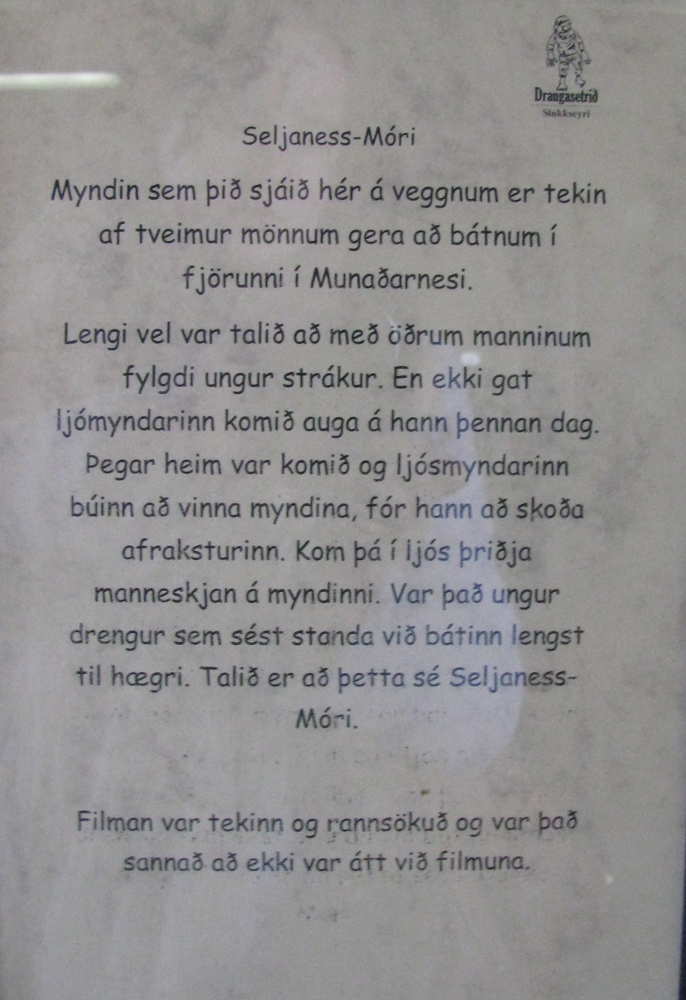Draugasetrið, the haunted ghost-museum. Posted by hulda on Oct 29, 2013 in Icelandic culture, Icelandic customs, Icelandic history
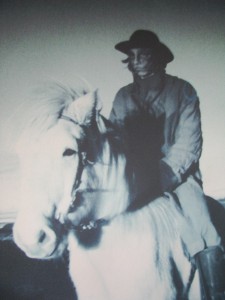 “The man whose voice you heard on the tape died a while ago. Ingólfur, who made the ghost movie also died recently, of cancer. Then I died too but they started me up again.”
“The man whose voice you heard on the tape died a while ago. Ingólfur, who made the ghost movie also died recently, of cancer. Then I died too but they started me up again.”
It’s a little bit difficult to take our ghost museum guide 100% seriously but as he is one of the specialists on the topic on Iceland, who’s to say it couldn’t be true? You would not necessarily be able to tell because Icelandic ghosts tend to be of the zombie variant, meaning that they’re very real and physical. Draugasetrid*, The Ghost Museum at Stokkseyri, boasts a thorough collection of not only Icelandic ghost stories but the ghosts themselves as well. Yes, real ones. The museum buildings themselves are said to be haunted and just to be on the safe side the staff always leaves food for one particular ghost of theirs that tends to be nicer to people when fed. “There’s a graveyard right next to us”, the guide mentions happily “so the rest of them probably take shifts”.
Draugasetrið has naturally been visited by teams of other ghost specialists and fans of the supernatural quite often. The room that’s believed to be the worst haunted was so convincing that not a single one of the people that have attempted to spend a full night in it over the time that the museum’s been here has been able to stay until the morning, with the record time so far apparently being 4 a.m. and no longer. In case of interest contact the museum and ask if they’ll let you try your courage!
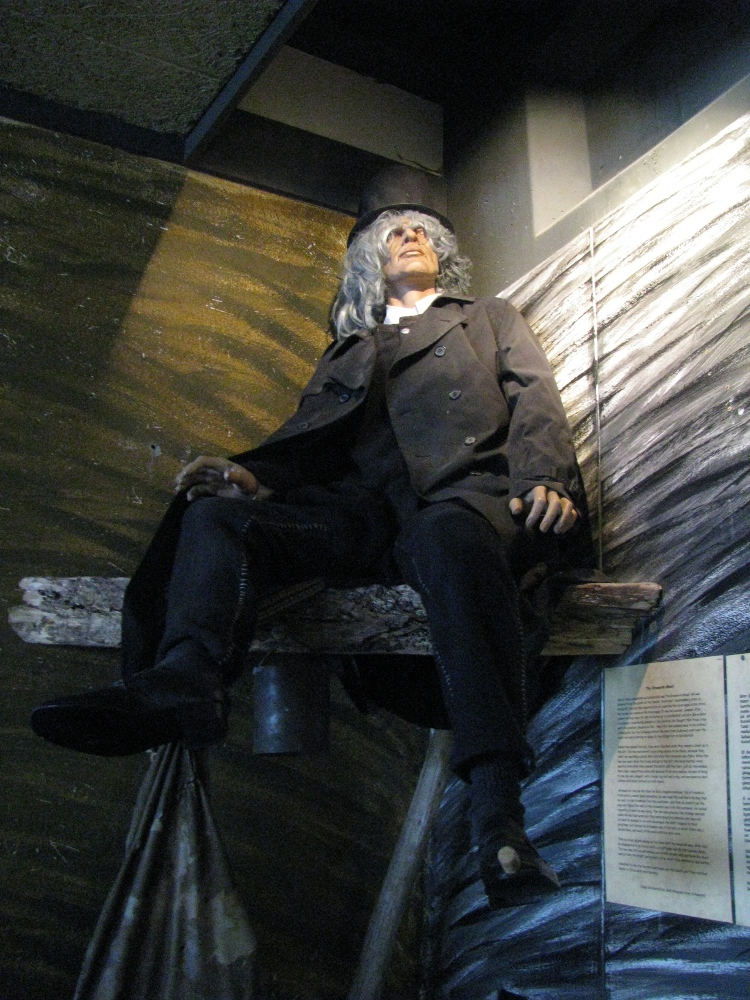 This fellow on the shelf is called the Brennivín ghost. Always dressed up in his best and with a huge can of brennivín he’s one of the more happy type of Icelandic ghost. Definitely enjoying his after-life. 🙂
This fellow on the shelf is called the Brennivín ghost. Always dressed up in his best and with a huge can of brennivín he’s one of the more happy type of Icelandic ghost. Definitely enjoying his after-life. 🙂
Returning to the topic on Icelandic ghosts, they actually don’t as much haunt places as they go after specifically chosen people, sometimes whole families, centuries upon centuries, causing bad luck, killing the members or driving them mad. This is usually the case of a ghost that’s either specifically woken by a magician to attack someone he doesn’t like, or one that bears a grudge, typically an útburður (= “outside – carried”). They are the most tragic type of a ghost Iceland has, spirits of newborn babies that were left outside to die. It may sound cruel, and it is that indeed, but bear in mind that at one point women who bore a child outside of wedlock faced a capital punishment regardless of the way the pregnancy had began. Abandoning the newborn could therefore be the only way of avoiding certain death – unless of course the newborn itself took this badly and came back for revenge.
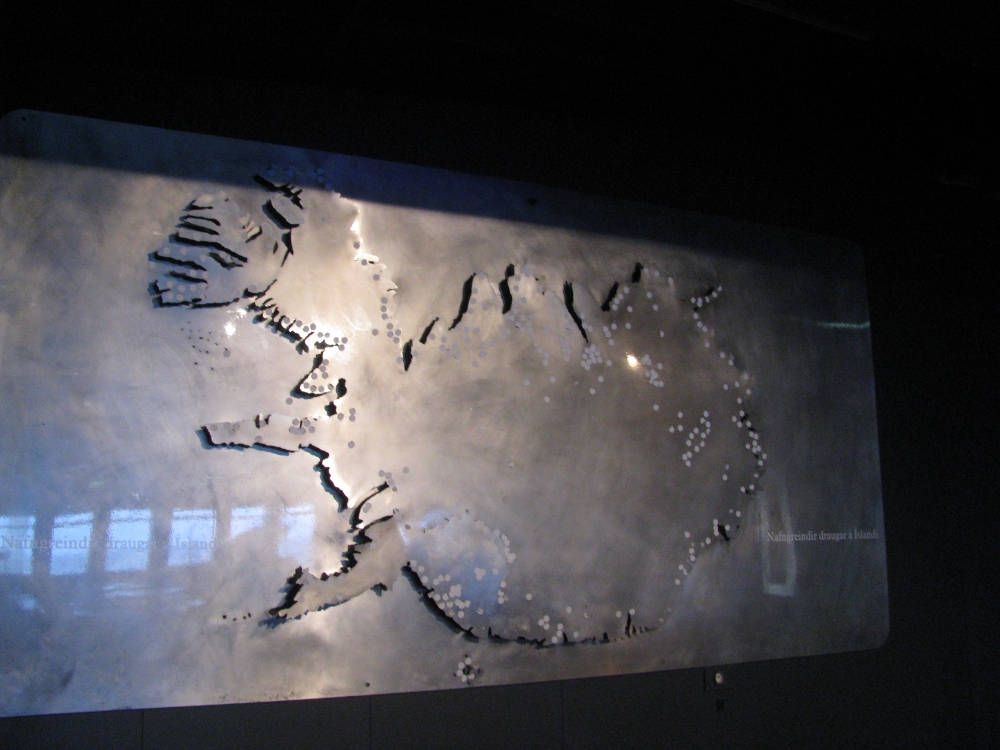 Every dot on the map marks a haunted place or a known ghost.
Every dot on the map marks a haunted place or a known ghost.
Sometimes a ghost only went after one person specifically. People who died while passionately in love with someone often followed their chosen one. Sometimes their beloved agreed to willingly go with them or the ghost deceived them to, as in the story called Djákninn á Myrká (= The deacon of Myrká)**. Other times even if the recipient of their emotions did not return them at all a ghost could still come back to haunt them, as was the case of Míklabæjar-Sólveig (= Sólveig of Míklabæ), a woman who committed suicide because of a broken heart and zombiefied right away to kill the man she had loved. Equally disturbing are the ghosts that sexually harass the living – there are any number of ghost stories where a woman has a child due to an attack by a ghost of a former suitor (1, 2, 3). There’s at least one known variant to this, a ghost of a man who haunts one specific stable and attacks men he finds attractive. He’s famous for striking the moment you turn your back to leave so men who visit the stable need to walk out of there backwards (women are reportedly safe).
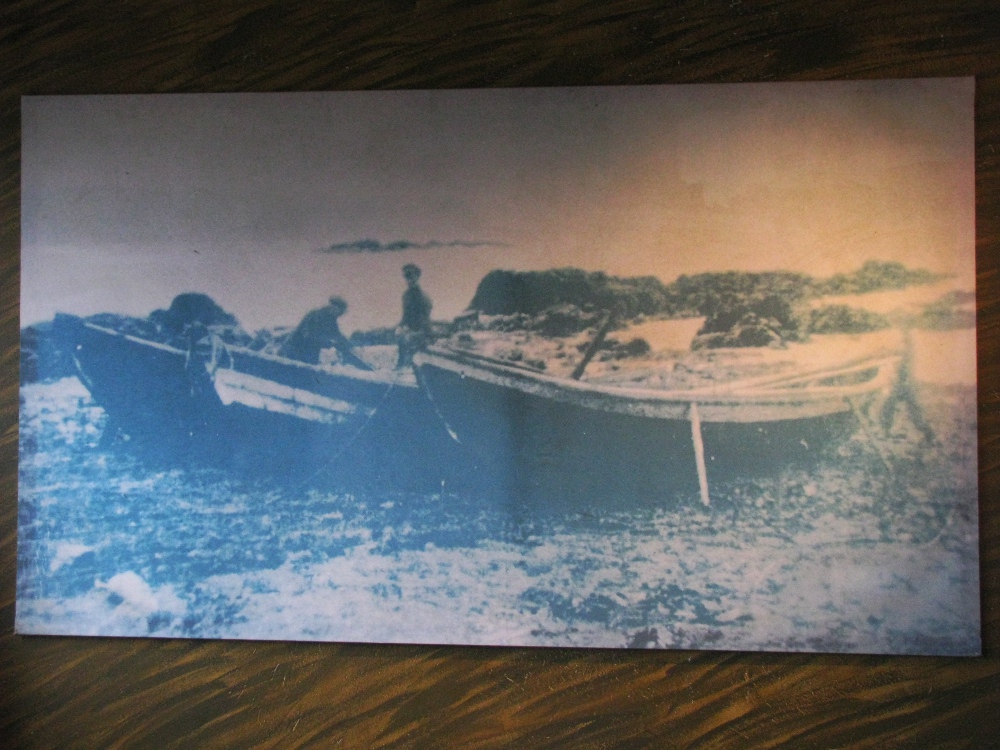 See three men in this photo? You shouldn’t. There were only two of them present on the day the photo was taken…
See three men in this photo? You shouldn’t. There were only two of them present on the day the photo was taken…
The picture shown here is taken of two men working at a boat on the beach at Munðarnes. It had often been said that the other one was followed by a young boy. However, the photographer was not able to see him on that day. Upon returning home he began to work on the photographs and saw the results. Then a third man had appeared on the photo. That was a young boy that seems to stand by the boat on the far right. It’s said that this is the Móri of Seljanes. The film was taken and studied and it could be proven it had not been tampered with.
This is just what’s so creepy about the Icelandic ghosts. You don’t necessarily have to do anything to be targeted by one. You don’t even have to know the ghost, it’s enough that you make someone else mad enough to rise a corpse and command it to follow and destroy you. Rising corpses in this manner isn’t safe though, so it’s advisable to try to sort out your disagreements in some other way first. Sending a ghost to kill someone who cannot be killed can at worst case make the ghost backfire on the sender and follow them instead, and some ghosts were even said to be so dependant on commands that after they had fulfilled them they began to torment their sender if they weren’t continuously given new targets.
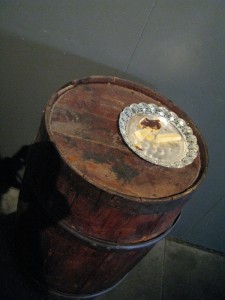 Food for the museum’s own Móri – hangikjöt (= smoked lamb) and cheese, his favourites.
Food for the museum’s own Móri – hangikjöt (= smoked lamb) and cheese, his favourites.
A typical Icelandic ghost does not wear white, nor is it transparent. Our guide tells us the white ghosts only arrived to Iceland from USA and did not last very long (perhaps the Icelandic variant overpowered them with sheer creepiness). The traditional Icelandic ghost wears ragged, grayish clothes with perhaps some amount of brownish red on them in case of the Móri and Skotta. The Móri are male ghosts and they’re often seen wearing a red shirt. The female ones are called Skotta, they wear sometimes a red shirt, sometimes red socks, but their trademark is a spoon-like traditional headdress with the spoon part either bending backwards or being otherwise heavily damaged.
 The food belongs to the Móri of Kambhól!
The food belongs to the Móri of Kambhól!
At the opening of the Ghost Museum the director of the museum promised to try and see to it that there would always be food at the table for the Móri of Kambhól. The story shows that the Móri of Kambhól was much friendlier to its hosts if he was given food. It’s known that he was given food both in Kampholt/Kambhól and Þingdal in Villingaholtshreppur. We warn you, dear visitors, against taking food from our Móri because we cannot take any responsibility of the consequences.
(Signed:) The directorate of the Ghost Museum.
How the Móri or Skotta come to be is somewhat open for discussion, but the two most common stories are that they either bear a severe grudge due to the way they died and/or were woken up by magic right after their death. In some cases magicians even murder someone to turn them into a Skotta or a Móri. Mývatns-Skotta was one such case: she was a poor girl who met a farmer with magic skills, was drowned by him and forced to wake up to follow a certain family that the farmer hated. She did that for centuries with great success. Interestingly the Icelandic ghost stories don’t have the usual moral undercurrent that would punish the evildoer, so the magician himself got away without as much as a scratch… It seems that in the Icelandic lore awful things happen simply because they do, because there are evil people in the world and also unlucky ones. One thing seems to always be the same: once you get targeted by a ghost there may not be any way to safety, just ways of postponing the inevitable. I’m surprised that of the few Icelandic monsters that have made it into horror movies ghosts don’t seem to be included because all this material could definitely keep you frightened for years!
Here’s a small guide to various ghost types and how to pronounce their names.
By the way, if you’re going to Stokkseyri next weekend the museum will have a special show on. When you enter the ghost area there may be Icelandic ghosts walking around there, either minding their own business or at worst case, yours. The guide said that it’s not for children though so be prepared that the ghosts there may be somewhat disturbing (as are the stories behind them). I’m not going to mention that graveyard again, but I might tell you this: the staff at the ghost museum all refuse to stay in the building after the visiting hours. There’s only one who does, our guide, and he seemed mildly unwilling too although he assured us he doesn’t mind the place – or its inhabitants.
*You can read more about the Draugasetrið here. It’s located a short drive away from Reykjavík, so in case you happen to come over and are interested it’s definitely worth visiting!
**The first photo of this entry is of the very same deacon of Myrká as in the story. Must be true since the photo’s in the museum.

Build vocabulary, practice pronunciation, and more with Transparent Language Online. Available anytime, anywhere, on any device.
About the Author: hulda
Hi, I'm Hulda, originally Finnish but now living in the suburbs of Reykjavík. I'm here to help you in any way I can if you're considering learning Icelandic. Nice to meet you!



